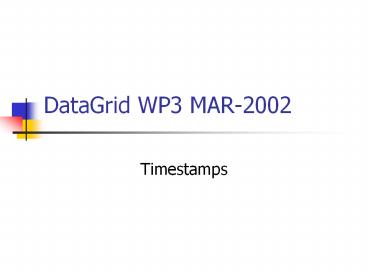DataGrid WP3 MAR-2002 PowerPoint PPT Presentation
Title: DataGrid WP3 MAR-2002
1
DataGrid WP3 MAR-2002
- Timestamps
2
Timestamps
- We would like the information system to associate
each measurement with the time it was made - We would like to handle fresh and archive data in
a uniform manner - All information must carry a timestamp
3
Timestamps what?
- ASCII timestamp
- Formatted string
- E.g 2002-01-16T124550.36Z
- Binary timestamp
- Local binary representation
- Linux two ints/longs
4
ASCII Format
- A number of efforts currently underway
- IETF currently has an RFC for defining date
time format for internet based on the standard
representation of dates and times ISO8601 - GGF also has a standard model, more or less same
But includes meta-info such as precision
accuracy information
5
ASCII Format
- IETF format
- Yyyy-mm-ddThhmmss.FfffZ
- T Z (specifies UTC) are compulsory
- GGF format (grd-perf-15-1)
- As above but with the inclusion of accuracy
resolution information - Yyyy-mm-ddThhmmss.FfffZxxxryya
- Number before r is the resolution, a is
accuracy - eg 2002-01-16T124648.7567Z.00000001r.00001a
6
Binary Format
- New/Current Unix struct timeval is implemented
using two long integers - First is 64-bit signed second value
- Last is 64-bit signed micro-second
- Not enough precision for future applications with
fractional part. - Resolution can be different for platforms and
programming languages
7
Timestamps
- How is time defined referenced ?
- Based on the rotation of the earth on its axis
Universal Time (UT/UT0/UT1/UT2) - TAI (Temps Atomique International )
- (a.k.a Atomic time) S.I. Second defined as
9192631770 cycles of the caesium resonance - UTC Time (Coordinated Universal Time)
- Same S.I. SECOND as TAI, but adjusted to include
steps (leap seconds) to keep within .9s of UT1
8
Timestamps
- How is time referenced ?
- In relation to the time-definitions epoch
- Each definition has a different epoch
- TAI 1-1-1958
- UTC 1-1-1972 (sort of)
- GPS 1-1-1980
9
Timestamps UT1,UTC TAI
- But UTC TAI n x (1s) and
- UTC kept within 0.9s of UT1 (irregular)
- Integer leapseconds since 1972
- TAI - UTC rebased to 10s
- IERS (Paris) determines when to introduce /-
leapsecond, very irregular - Introduced as an extra second at end of a month
(currently only June and December used)
10
Leapseconds -problem
- Problem converting between ASCII and binary (UTC)
timestamps - Must possess times at which leapsecond was
introduced - All sites/nodes must view the same information
- A second is represented by an integer from 0 to
60 the values 60 and 61 occur only for leap
seconds and even then only in Java
implementations that actually track leap seconds
correctly JDK documentation
11
Leapseconds, an example
- Normal (common) year (365 x 86400) seconds
- 1998 lasted longer (due to aggregate deceleration
of the earth due by tidal forces) - A leapsecond was introduced by IERS
- 1-December-1998 235958
- 1-December-1998 235959
- 1-December-1998 235960 (1s)
- 1-December-1998 000000
12
Problem- Timestamp Conversion
b consumes information Ia(ta)
a
b
Sites a c are corrected for leap seconds, b is
not When b utilises Ia(ta) it must first convert
to binary, this value is now incorrect, by as
much as 32 seconds, but at least 1.
a, produces information Ia with timestamp
ta Ia(ta)
c
c, also consumes information Ia(ta)
13
Solution
- All sites obtain leapsecond information from the
same information producer - Use R-GMA
- Only need one node to obtain data from USNO ftp
site. - This node will publish information via a
DBProducerServlet - Timestamp class will use this information to
convert between formats
14
Solution (Part A)
DB Producer Servlet
Leapsecond prod
U.S.N.O.
DB Producer
Consumer Servlet
SQL-DB
Consumer
Timestamp obj
Leap Second data
Application
(Local Cache)
15
Solution (Part B)
- ASCII to binary conversion
- ASCII ta -gt Binary tb
- Find corresponding leapsecond value, L for ta
- Corrected binary value tb L
16
Solution (Part B)
- Binary to ASCII -gtconversion
- Binary ta -gt ASCII tb
- Find corresponding leapsecond value, L for ta
- Corrected binary value tb - L
- Easy to reverse engineer the ASCII fields from
the binary second amount
17
Solution (Part B)
- ASCII --gt binary --gt ASCII
- 450MHz P2 Sun JDK
- cache file size adapts to no.leapseconds since
1972 22 so far - 20mS startup to read from cache file when
timestamp object is instantiated - 225 sec for 106 conversions
- tested multiple ve and -ve leapseconds
- Blackdown order-of-mag. slower - why ?
18
Solution (Part B)
- Must decide upon Binary and ASCII second fraction
format. - UNIX binary fraction is given as the elapsed
micro-seconds (resolution not good enough for
future applications) - GGF were proposing a binary fraction of a second
value (regressed to ASCII only) - IETF only have a decimal fraction of variable
length
19
The Earth Was Created 4 Billion Years Ago
- Must decide on an epoch for binary timestamps
- NTP 1/1/1900 TAI 1/1/1958
- UNIX 1/1/1970 UTC 1/1/1972
- GPS 1/1/1980 Y2K 1/1/2000
- Most sensible TAI, UTC or Y2K
- Easy to convert from others
- UNIX -gt non-integer leapsecond value
20
To do
- Decide upon
- Epoch
- Minimum binary fraction-of-second format
- Accuracy/resolution info
- Write CRON scripts
- to obtain leapsecond info from USNO
- to populate cache files
- to randomize the timing of these actions

